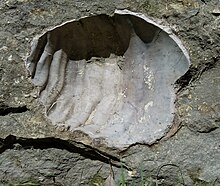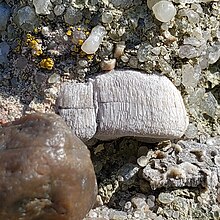Cremnoceramus ("cremno-" = kremnos [Greek]: precipice or over hanging wall or bank; "ceramus" = keramos [Greek]: clay pot) is an extinct genus of fossil marine pteriomorphian bivalves that superficially resembled the related winged pearly oysters of the extant genus Pteria. They lived from the Turonian to the Maastrichtian of the Late Cretaceous.[2][3]
| Cremnoceramus
| |
|---|---|

| |
| Cremnoceramus deformis in early Turonian Fort Hays limestone, showing characteristic wavy rugae.[1] | |
| Scientific classification | |
| Domain: | Eukaryota |
| Kingdom: | Animalia |
| Phylum: | Mollusca |
| Class: | Bivalvia |
| Order: | Pteriida |
| Family: | †Inoceramidae |
| Genus: | †Cremnoceramus Cox, 1969 (posthumous) |
| Species | |
| |

Cremnoceramus were facultatively mobile, blind, suspension feeding bivalves with low-magnesium calcite shells.[3] Inoceramids, like the Cremnoceramus in particular, had thick shells composed of particular "prisms" of calcite deposited perpendicular to the surface, and unweathered fossils commonly preserve the mother-of-pearl luster the shells had in life.[4] Compared to the many examples of broad and flattened Inoceramidae, Cremnoceramus shells are rather "high-walled", deep bowl-shaped. The top shell is commonly encrusted with oysters.
The following species are recognized:[5]
The first appearance of the species Cremnoceramus rotundatus marks the beginning of the Coniacian stage.
Fossils of the genus have been found in:[6]
Note the oyster encrustation of the top shells:
This article about a Cretaceous animal is a stub. You can help Wikipedia by expanding it. |
This article about a prehistoric bivalve is a stub. You can help Wikipedia by expanding it. |